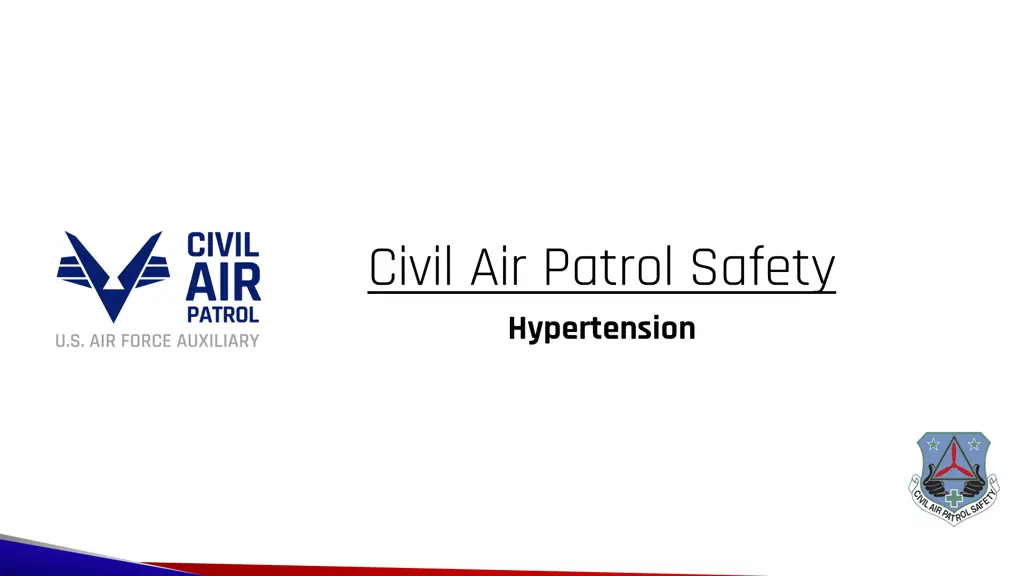Civil Air Patrol Safety
Learn about the definition and measurement of blood pressure, as well as the causes and complications of hypertension.
Download Presentation

Please find below an Image/Link to download the presentation.
The content on the website is provided AS IS for your information and personal use only. It may not be sold, licensed, or shared on other websites without obtaining consent from the author.If you encounter any issues during the download, it is possible that the publisher has removed the file from their server.
You are allowed to download the files provided on this website for personal or commercial use, subject to the condition that they are used lawfully. All files are the property of their respective owners.
The content on the website is provided AS IS for your information and personal use only. It may not be sold, licensed, or shared on other websites without obtaining consent from the author.
E N D
Presentation Transcript
Civil Air Patrol Safety Hypertension
Definition Blood Pressure: Each time your heart contracts, it causes a wave or pulsation in the blood system of the body. This can be seen very clearly when an artery is cut and the blood spurts out of the cut vessel with each beat of the heart. Measuring Blood Pressure: This is usually accomplished by putting a cuff around the upper arm and inflating the cuff with air. Once the air pressure in the cuff exceeds the pressure in the artery below the cuff, the flow of blood beyond the cuff stops. As the air pressure is slowly lowered, there comes a point at which blood begins to flow through the artery again (the systolic pressure) that can be heard or felt over the artery below the cuff. In between beats, the artery closes, and blood flow stops again. As the pressure is lowered further, a point is reached at which the artery stops closing between heart beats, called the diastolic pressure. Blood pressure is usually measured in terms of millimeters of mercury (or mm Hg) 2
Definition - cont. Systolic: This is the highest or peak pressure reached in the blood vessel during each contraction of the heart. Diastolic: This is the lowest pressure in the system during the time the blood pressure is being measured and coincides with the relaxation phase of the heart contraction. Normal blood pressure: Normal Systolic pressure is usually between 90 - 140 mm Hg. An ideal level for an adult is about 120 mm Hg. Normal Diastolic pressure is usually between 60 - 90 mm Hg. An ideal level for an adult would be 70 - 80 mm Hg. 3
Definitions - cont. Hypertension: This refers to an abnormally high blood pressure. Pre-hypertension is indicated by a systolic pressure between 130 -140 mm Hg Stage 1 hypertension is indicated by a systolic pressure between 160 180 mm Hg Stage 2 hypertension is indicated by a systolic pressure greater than 180 mm Hg Hypotension: This refers to an abnormally low blood pressure Shock: Is a condition where the blood pressure is abnormally low, and the body is beginning to shut down . 4
Causes of hypertension Smoking Certain hormonal conditions, like adrenal or thyroid disease Obesity Excess salt/sodium in the diet Sedentary lifestyle Age Sleep Apnea Drugs and Alcohol Overall poor diet Kidney Disease Diabetes Medication side-effects Stress 5
Complications of Hypertension Stroke Heart Attack Atherosclerosis (hardening of the arteries) Kidney disease Eye disease Problems in pregnancy (eclampsia) Erectile dysfunction 6
Recognition and Identification Hypertension is identified through the measurement of one s blood pressure. There are few symptoms that indicate the presence of hypertension and in many people, virtually no recognizable symptoms are noticed. Blood pressure can be checked at medical offices, dental offices, pharmacies and many other locations, as well as at home. Home blood pressure monitoring has several advantages and often is a more accurate indication of one's day to day blood pressure. 7
Treatment Treatment for hypertension potentially involves both lifestyle modification and medication Lifestyle modifications can include: Smoking cessation Weight loss Exercise and physical activity Reducing the amount of alcohol, sodium and fat consumed Stress management and relaxation techniques 8
Treatment - cont. Medication: When lifestyle modification is not sufficient to keep the blood pressure in a healthy range, medications may be necessary. There are many categories of medication that a physician can prescribe: Diuretics or fluid pills. These reduce the blood volume through their effects on the kidneys. ACE inhibitors: These also work through the kidneys to influence an important hormonal system. Beta blockers: These medications work primarily on the heart to reduce the strength of the heart contraction and slow the rate of contractions. Calcium channel blockers: This group of medications slows down the heart contractions. 9
































